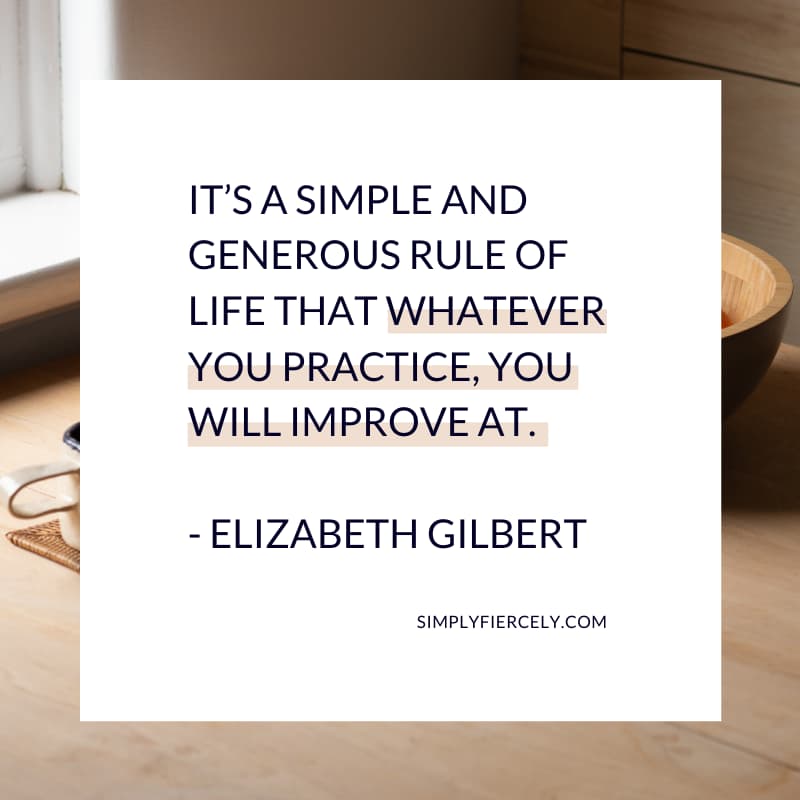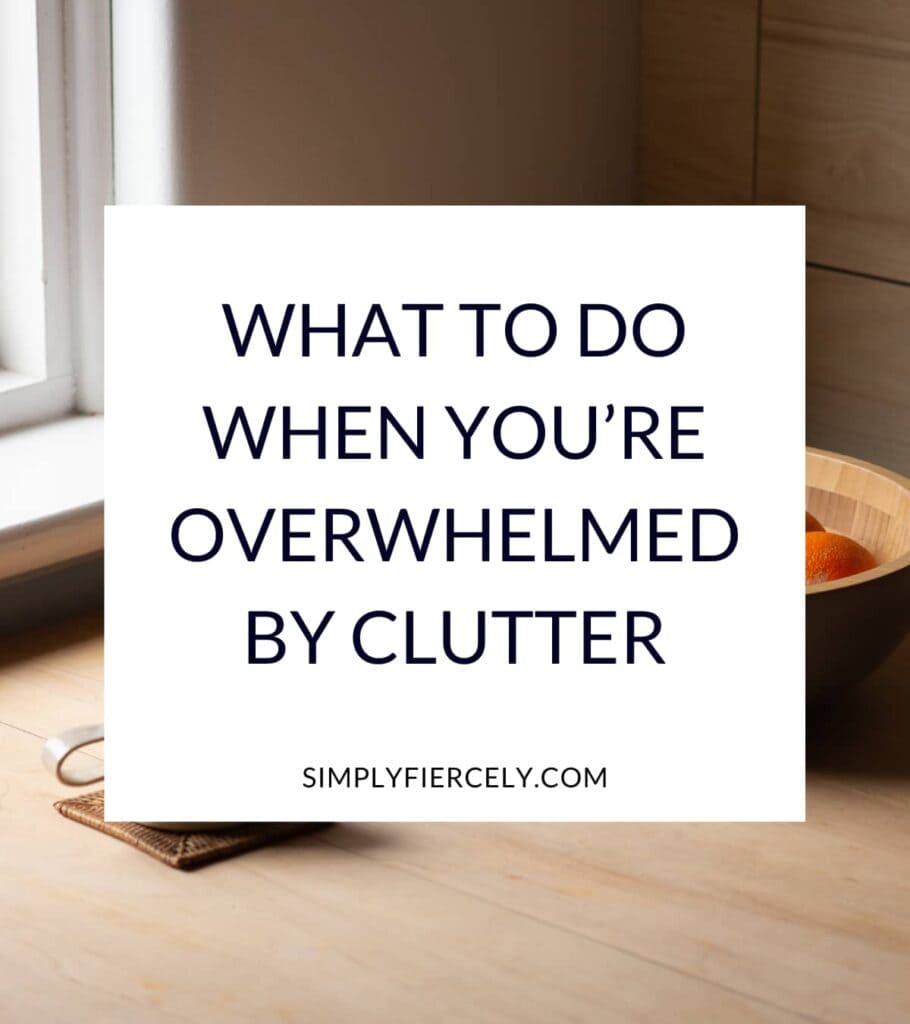As a former shopaholic turned minimalist, I understand what it’s like to feel overwhelmed by clutter—but I also know how to tackle it. These simple decluttering tips will help you get started, even if you feel like you’re drowning in too much stuff.
Once upon a time, I had a wardrobe so big that I turned my entire guest bedroom into a closet. I had floor-to-ceiling Ikea built-ins and custom racking to house my enormous shoe collection (well over 100 pairs!).
And that was just one room in my house. My kitchen cupboards were brimming with op-shop finds and an assortment of dinnerware (for the parties I dreamed of hosting but, of course, never did because my house was such a cluttered mess).
There were also plastic storage tubs everywhere, piled in corners and under the stairs. I’d moved several times with these boxes, and honestly, I don’t even know what they contained. Still, I wasn’t ready to let go. Instead, I would “organise” by periodically moving them from one room to the other.
I’m sharing this because a lot of people are overwhelmed by clutter and need to know they’re not alone.
I’ve walked in your shoes, and I know that at some point, things got out of control, and now, you feel paralysed. You want something different for your home and life, but you have absolutely no idea how or where to begin.
If this resonates with you, take a deep breath. A clutter-free home is possible, and we’re going to tackle your stuff together.

How To Start Decluttering When You’re Overwhelmed
The first thing to know is that feeling stressed and overwhelmed is usually less about how much clutter you have and more about your confidence in dealing with it. Believe it or not, this is good news.
Why? Because decluttering is a skill. You might not feel capable now, but that doesn’t mean you won’t get there eventually. It’s like learning to drive. At one point, it probably felt completely unnatural and overwhelming to sit behind the wheel of a car. But now, it’s second nature.
One day, you might feel the same about decluttering, but regardless, have faith that not knowing what to do is natural at first. Don’t beat yourself up or compare your progress to others. Instead, give yourself permission to learn and make mistakes.
Embracing a beginner’s mind will help you overcome the paralysis, so you can find the courage to get started. Then try these five simple steps that will help you declutter your home, even when you’re overwhelmed with too much stuff.

Step 1: Stop adding to the problem
Imagine if a pipe burst in your home right now. How would you react? Naturally, you would quickly find a bucket, but then what?
You’d turn the water off at the source.
Of course, you’d want to clean up the mess ASAP, but it’s obvious that there’s no point in cleaning while water is pouring out everywhere. The same logic applies to decluttering your home.
Before you start clearing out your unwanted goods, you need to take a long hard look at where your clutter comes from, and a great first step is examining your shopping habits.
Sit down and take 10 minutes to reflect on the shopping you’ve done in the last month. If you use a debit or credit card, it’s helpful to review your statements. What are you buying, and is it contributing to your clutter?
If so, I highly recommend you check out this article, where I outline four common reasons why people can’t stop shopping (along with practical strategies you can implement right away).
Don’t skip this step. It doesn’t matter how much you eventually declutter—if you haven’t learned how to stop clutter from entering your home in the first place, any results you achieve will be short-lived. By addressing the issue at its core, you can save yourself a lot of time and effort in the long run.
Related Post: How to Stop Buying Clothes You Never Wear
Step 2: Cultivate the right mindset
The next thing I recommend everyone do is to work on their mindset —and I know this isn’t typical advice, but honestly, it has made the biggest difference on my own decluttering journey.
Over the years, I’ve come to realise that our possessions are not just “stuff”; they are reflections of our thoughts and beliefs. This is why letting go can be so hard. When we declutter, we’re not only releasing physical items, but we’re also decluttering old identities, fears, insecurities, and much more.
It can be messy emotional work but don’t let it scare you. As with anything, the key is to start small.
I recommend an approach that I refer to as Mindful Decluttering. It involves clearly defining what you want from your home and life and then consciously working towards that vision by decluttering and letting go.
It involves a mindset shift from scarcity to abundance. Decluttering is not about giving things up. Instead, it’s about editing your home and life to make more space for the things that matter most.
To help you, I created a free guide with step-by-step instructions, troubleshooting tips, and even a workbook. You can get instant access by subscribing using the form below. (As a bonus, you’ll also receive my regular newsletters with special offers, personal stories, and lots of tips—but don’t worry, you can unsubscribe anytime and still keep the guide!)
Step 3: Choose one small project
Once you’ve laid the groundwork, it’s time to take the next crucial step: selecting a project to begin your decluttering.
Now, I know this may seem obvious, but often the confusion surrounding decluttering arises from contemplating the enormity of the task at hand—thinking about your entire house and the overwhelming amount of work you need to do. Where in reality, even tackling an entire room can be too much to handle in the beginning.
Instead, a highly effective approach is to focus on a small area of your home. Not only is it easier to wrap your head around, but you might also be able to complete it in a single decluttering session, providing a quick win and igniting the momentum you need.
While I’ve dedicated an entire post to guiding you on where to start decluttering, here are a few strategies to consider (keeping in mind that the right starting point may vary based on your personality):
- If you love checking things off a to-do list … start with a small space and avoid sentimental items. Consider starting with your junk drawer or the cabinet under your bathroom sink—these areas are perfect for achieving a quick win early on and harnessing the momentum to keep you going.
- If you get bored easily or struggle with motivation … try an exciting project instead of an easy one. This might mean creating a special reading nook in your living room or clearing your kitchen counters to make room for fresh flowers. By making decluttering an enjoyable experience rather than a chore, you’ll find it easier to stay engaged and motivated.
- If you’re exhausted and having a hard time making decisions … try working from a decluttering checklist or participate in a decluttering challenge. While you still need to choose a specific area to begin with, having some structure and guidance can alleviate the burden on your mind and provide a sense of direction.
Remember, deciding where to start goes beyond simply selecting a space to declutter—it also involves aligning your strategy with your goals. By choosing the right approach, you’ll find it much easier to maintain motivation in the long run.
The Simply + Fiercely Show is a podcast for women who want to clear their clutter and create space for freedom and joy. If your life keeps getting bigger—but not better—then it’s time to declutter from the inside out. LISTEN NOW
Step 4: Establish clear decision-making guidelines
This step is an essential yet often overlooked part of the decluttering process.
If you’re struggling with the feeling of overwhelm, the best way to begin is with structure and boundaries. Ultimately, this will simplify decision-making and relieve a lot of the stress that comes with decluttering.
Practically speaking, this looks like writing some hard rules about what does or doesn’t belong in the space you’re working on. Think broadly and take a big picture approach before you start making decisions about individual items.
For example, let’s consider your closet. What rules can you set for yourself there? Are there colours, fabrics, or certain styles that you no longer want to wear? (Personally, I don’t wear yellow, I’m done with polyester, and I don’t have anything that’s dry-clean only.)
By predefining these rules, you provide yourself with a framework that helps you make quick decisions. You’ll feel less overwhelmed because you’ll have a personalized roadmap to guide you along the way.
Pro Tip: Trying to get your family members on board with decluttering? Have this discussion with them and see if you can create any boundaries or guidelines together.
STEP 5: Identify + tackle your roadblocks
Finally, it’s important to know that no matter how much you prepare, you’re going to come up against roadblocks. I point this out because, too often, people want to give up as soon as things get tough.
The overwhelming feelings are just too much, and they think it’s a sign of failure or proof that it’s all too hard—but honestly, this couldn’t be further from the truth. Instead, I believe your struggles are a sign that you’re headed in the right direction. (It’s all part of the emotional cycle of decluttering.)
You’re doing the work, and every challenge is an opportunity for growth. When you get stuck, don’t turn away disheartened. Instead, face it head-on with an open and curious mind. Ask yourself what fears, thoughts or beliefs are holding you back.
Keep in mind that clutter is often a symptom of a bigger problem. For example, I shopped obsessively for expensive clothes and shoes because I struggled with insecurity and self-acceptance. I had to acknowledge and address these deeper issues first in order to feel comfortable with letting go.
You need to get to the heart of your roadblocks—this is essential to not only decluttering your home but also simplifying your entire life. But be patient with yourself, and don’t let unrealistic expectations overwhelm you.
You’re learning new things and also unlearning a lifetime of deeply held beliefs. This takes time, so move forward with grace, slowly, one foot in front of the other.
More Decluttering Tips + Resources
If you’d like to learn more about decluttering your home and life, here are some resources that you might find helpful:
Also, I want to remind you that it’s OK if you need a little help before you can begin.
Sometimes that looks like working with a professional organizer—or the next step might even mean working with a therapist. Emotional attachment to stuff can be a reflection of things from our past where we need closure, and until we find it, it’s hard to let go.
Regardless, be kind to yourself and know that if you need support, I’m here cheering you on!
What do you do when you feel overwhelmed by clutter? Let us know in the comments!


